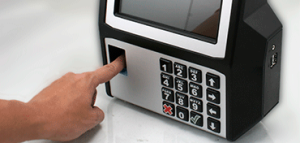
To ease those concerns, we will address some frequently asked questions regarding biometric time clocks as well as explain how fingerprint data is collected and stored on EPAY’s WalTer T6 biometric time clock.
Frequently Asked Questions About Biometric Time Clocks:
Q. How secure is the system’s communication?
A. The system is linked to secure servers. All information collected on the biometric terminals is encrypted using Triple-DES and 128-bit encryption technologies.
Q. Is personal information shared with the server?
A. Employee personal information, such as fingerprint images, are NOT shared and are not sent to the server. In fact, fingerprint images are actually destroyed upon capture.
Q. Is employee information shared with any government agencies or third party companies?
A. Employee information is absolutely NOT shared with any agencies or third parties. The information is used solely for payroll purposes.
So, How Do Biometric Terminal Clocks Work?
- First, the system takes a scanned fingerprint image.
- It then creates a small mathematical representation, using binary code, summarizing the fingerprint information. This mathematical representation is called a “minutia”.
- Next, the system destroys the fingerprint image.
- Finally, the minutia file is stored in the system for matching (though a fingerprint cannot be recreated from the minutia). The next time the employee clocks into the biometric terminal, the system compares the earlier stored file with the newly created minutia, which is created from the most recent fingerprint image and then immediately destroyed.
- If there’s a match, it allows the employee to clock in.
- If there’s no match, it then asks the employee to try again.
- After two failed trials, the system allows the employee to clock-in anyway, but it flags the punch and notifies the on-site supervisor that the employee was not able to match. The supervisor will have to approve the punch.
Learn more about our biometric time clocks here.
